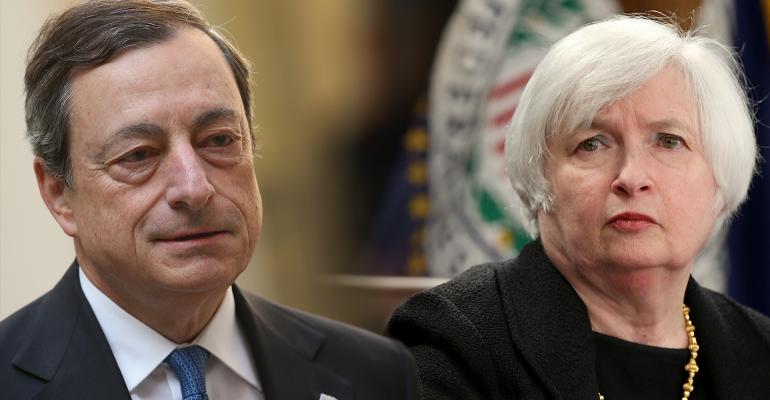Investors are anticipating the likely decisions by the heads of the Federal Reserve and the European Central Bank in December and weighing their relative impact on markets. Interest rates thus continue to be the main driver of markets and in our view can lead to some short term volatility. However, we believe that when taken together, global central bank policies will remain supportive for risk appetite in the medium term and we maintain an overweight position in equities in our model portfolios, especially in Europe and China (H-shares).
- Market volatility has principally been driven by a sharp re-assessment of rate hikes in the US.
- However, US rate hike expectations need to be weighed against the likelihood of a more accommodative policy in the Eurozone and elsewhere.
- Global policy measures thus remain supportive for risk appetite and we continue to maintain an overweight position in equities.
- Nevertheless, policy differentials can have a significant effect on currencies and regional performance.
- The temporary strength in USD may be an obstacle for EM and commodities.
Markets well underpinned but waiting for central bank meetings
In recent weeks, markets have sharply re-assessed the chances of the Federal Reserve finally raising interest rates after keeping them unchanged since December 2008. This re-assessment is due to a combination of factors, including more positive US labour market data, lower perceived downside risks coming from abroad (i.e. principally China) and a change in the tone of some Federal Reserve officials. We agree that the Fed is likely to hike at its meeting on 16 December.
Although a first rate hike has been anticipated for a long time and has given investors time to adjust their positions, there is a general sense that the trigger point is now more imminent. Hence, it is normal to see some reaction in markets, such as the increase in government 10-year Treasury yields (from 1.98% to 2.34% between 14 October and 9 November), the rise in US high yield spreads (from 545 to 595 basis points) or the rise in equity market volatility (from 14.3% to 20.1%). (Data sourced from Bloomberg)
Risk assets may continue to be sensitive to data and markets’ assessment of Fed action ahead of the meeting, but we also note that markets have bounced back recently. While it is premature to rule out any further downside, we think there are a number of factors that should continue to support equities and credit, with a 6 month view.
HSBC Private Bank Maintains an Overweight Position in Global Equities
HSBC Private Bank remains constructive on riskier assets, with an overweight in global equities and European credit.
- Central bank action remains supportive when considered from a global perspective.
- Global economic data is generally benign.
- China continues to be a swing factor in global sentiment but we see some positive developments.
- Finally, positioning is not stretched.
Follow the Liquidity
We think that Eurozone assets will continue to outperform as a result of liquidity trends. As the ECB is adding continued liquidity in the market through its bond purchases, this liquidity has a good chance of staying in the region and being put to work in local asset markets. In addition, fund flows continue to prefer Eurozone assets.
Emerging market assets had seen outflows for most of the year, but recently these outflows have eased. We think it may be too premature to expect strong inflows, especially until the Fed and ECB meetings are behind us and their decisions have been digested by the market. We thus continue to focus on EM Asia, where we think that the actions by Chinese authorities will help raise investor confidence.
In summary, we are not making any changes to our model portfolios, our equity or bond allocations, or our regional preferences.
We think that the first rate hike will be a ‘dovish hike’, as it will be accompanied with dovish guidance and an indication that any further rate hikes will be shallow. Coupled with dovish monetary policy in the Eurozone and Japan, as well as benign global economic data, we think that this will allow equities to bounce back in coming months.
Some volatility is likely ahead of the meetings and their immediate aftermath, and we thus maintain a diversified approach with a measured overweight to riskier assets.
Jose A. Rasco is the Chief Investment Strategist for HSBC Private Bank-Americas. He is a member of the Global Private Bank Investment Committee. This column is for informational purposes only. It consists of general market commentary and should not be relied upon as investment advice.





